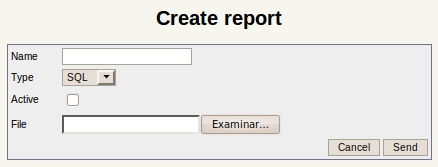Difference between revisions of "Reports"
| Line 85: | Line 85: | ||
You can finde the whole report at [[File:LockedDocuments.jrxml]] and [[File:SubscribedDocuments.jrxml]]. | You can finde the whole report at [[File:LockedDocuments.jrxml]] and [[File:SubscribedDocuments.jrxml]]. | ||
| + | |||
| + | == Reports with parameters == | ||
| + | Since OpenKM 5.1.7 reports feature has been improved and now you can create reports with parameters. This enables the possibility of creating more dynamic reports. | ||
| + | |||
| + | To achieve this you need to package the report in a archive with '''rep''' extension. This archive will contain the report itself and a XML file called '''params.xml''' which describe the report parameters. This file name is mandatory, this means that it need to be called '''params.xml''' or won't work. You can create a ZIP archive from these files and rename the extension to "rep". | ||
| + | |||
| + | Let's see a sample '''params.xml''' file: | ||
| + | |||
| + | <source lang="xml"> | ||
| + | <?xml version="1.0" encoding="UTF-8"?> | ||
| + | <!DOCTYPE report-parameters PUBLIC "-//OpenKM//DTD Report Parameters 2.0//EN" | ||
| + | "http://www.openkm.com/dtd/report-parameters-2.0.dtd"> | ||
| + | <report-parameters> | ||
| + | <input label="Path" name="path" type="folder"/> | ||
| + | </report-parameters> | ||
| + | </source> | ||
| + | |||
[[Category: Administration Guide]] | [[Category: Administration Guide]] | ||
Revision as of 09:31, 19 July 2011
In report section you can create and use your own Jasper Reports. Reports are generated in PDF format. Starting from OpenKM 5.1 other formats can be generated.
Add new report
Then make click ![]() new report icon
new report icon
Report can use internally Scripting or SQL. The file to uploading must be .jrxml JasperReport source file. Starting with OpenKM 5.1 you can also upload compiled reports (files with .jasper extension).
Types of reports
SQL Report
Usually you have a database and want to generate a report extracting data from it. In this case you should know the table relationship. Tools like Aqua Data Studio can help you to create a ER diagram. In this example, will query the database to generate a report with information related to workflow execution:
select ti.actorid_ as ti_actorid, pd.name_ as pd_name, ti.name_ as ti_name, ti.start_ as ti_start, ti.end_ as ti_end
from JBPM_TASKINSTANCE as ti, JBPM_PROCESSINSTANCE as pi, JBPM_PROCESSDEFINITION as pd
where ti.procinst_ = pi.id_ and pi.processdefinition_ = pd.id_
order by ti_actorid, pd_name, ti_name, ti_start, ti_end
Full report is available at File:WorkflowWorkload.jrxml.
Script Report
Other times, the data is not extracted from a database but another source. In this case we will query the OpenKM API to obtain a list of registered users.
import com.openkm.dao.*;
import com.openkm.dao.bean.*;
List al = new ArrayList();
for (User user : AuthDAO.findAllUsers(false)) {
Map usr = new HashMap();
usr.put("id", user.getId());
usr.put("name", user.getName());
usr.put("email", user.getEmail());
usr.put("roles", user.getRoles().toString());
al.add(usr);
}
return al;
This means that not only database-managed user are show but also if you have configured OpenKM to use an external LDAP server to handle user management.
Full report is available at File:RegisteredUsers.jrxml.
XPath Report
If you want to create a report which uses an XPath query, use scripting to do the trick. This code will query for locked documents:
import javax.jcr.*;
import javax.jcr.query.*;
import org.apache.jackrabbit.*;
import com.openkm.module.direct.*;
List al = new ArrayList ();
String statement = "/jcr:root/okm:root//element(*,okm:document)[@jcr:lockOwner]/@jcr:lockOwner";
String type = "xpath";
Session jcrSession = DirectRepositoryModule.getSystemSession();
Workspace workspace = jcrSession.getWorkspace();
QueryManager queryManager = workspace.getQueryManager();
Query query = queryManager.createQuery(statement, type);
QueryResult result = query.execute();
for (RowIterator it = result.getRows(); it.hasNext();) {
Map ld = new HashMap();
javax.jcr.query.Row row = it.nextRow();
javax.jcr.Value v = row.getValue(JcrConstants.JCR_LOCKOWNER);
ld.put("owner", v==null?"NULL":v.getString());
v = row.getValue(JcrConstants.JCR_PATH);
ld.put("path", v==null?"NULL":v.getString());
al.add(ld);
}
return al;
You can finde the whole report at File:LockedDocuments.jrxml and File:SubscribedDocuments.jrxml.
Reports with parameters
Since OpenKM 5.1.7 reports feature has been improved and now you can create reports with parameters. This enables the possibility of creating more dynamic reports.
To achieve this you need to package the report in a archive with rep extension. This archive will contain the report itself and a XML file called params.xml which describe the report parameters. This file name is mandatory, this means that it need to be called params.xml or won't work. You can create a ZIP archive from these files and rename the extension to "rep".
Let's see a sample params.xml file:
<?xml version="1.0" encoding="UTF-8"?>
<!DOCTYPE report-parameters PUBLIC "-//OpenKM//DTD Report Parameters 2.0//EN"
"http://www.openkm.com/dtd/report-parameters-2.0.dtd">
<report-parameters>
<input label="Path" name="path" type="folder"/>
</report-parameters>

